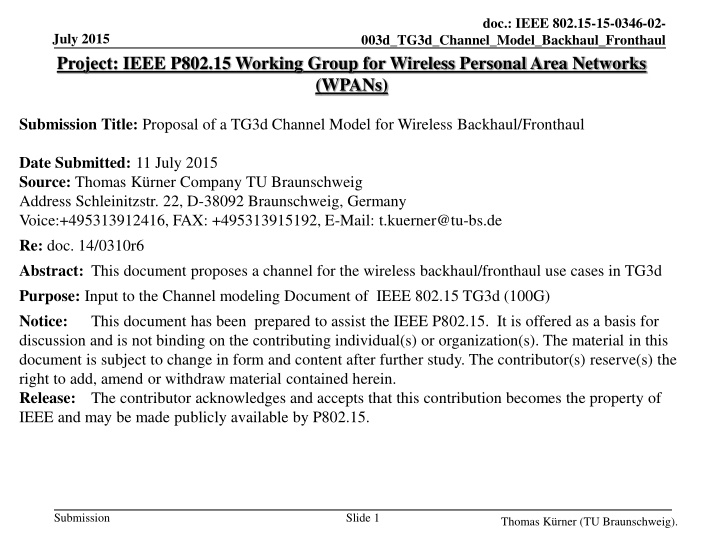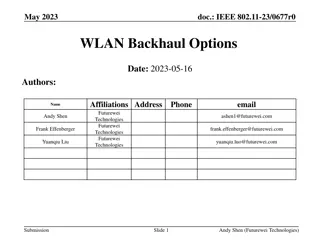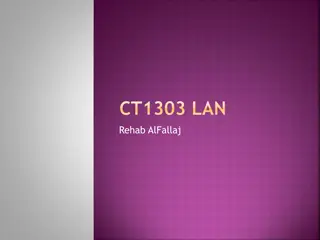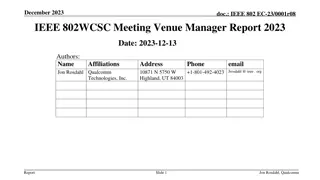Proposal of TG3d Channel Model for Wireless Backhaul/Fronthaul in IEEE 802.15 Working Group
This document presents a proposal for a TG3d channel model intended for wireless backhaul/fronthaul applications within the IEEE 802.15 Working Group. The proposal addresses operational characteristics, including high path loss mitigation at 300 GHz, requiring high gain antennas for LOS connections. Relevant propagation characteristics such as atmospheric gas attenuation, rain attenuation, and cloud/fog attenuation are discussed as factors contributing to increased free space loss. The document emphasizes the necessity of high gain antennas and spatial filtering to achieve reliable transmission over several hundred meters.
Download Presentation

Please find below an Image/Link to download the presentation.
The content on the website is provided AS IS for your information and personal use only. It may not be sold, licensed, or shared on other websites without obtaining consent from the author.If you encounter any issues during the download, it is possible that the publisher has removed the file from their server.
You are allowed to download the files provided on this website for personal or commercial use, subject to the condition that they are used lawfully. All files are the property of their respective owners.
The content on the website is provided AS IS for your information and personal use only. It may not be sold, licensed, or shared on other websites without obtaining consent from the author.
E N D
Presentation Transcript
doc.: IEEE 802.15-15-0346-02- July 2015 Project: IEEE P802.15 Working Group for Wireless Personal Area Networks (WPANs) 003d_TG3d_Channel_Model_Backhaul_Fronthaul Submission Title: Proposal of a TG3d Channel Model for Wireless Backhaul/Fronthaul Date Submitted: 11 July 2015 Source: Thomas K rner Company TU Braunschweig Address Schleinitzstr. 22, D-38092 Braunschweig, Germany Voice:+495313912416, FAX: +495313915192, E-Mail: t.kuerner@tu-bs.de Re: doc. 14/0310r6 Abstract: This document proposes a channel for the wireless backhaul/fronthaul use cases in TG3d Purpose: Input to the Channel modeling Document of IEEE 802.15 TG3d (100G) Notice: This document has been prepared to assist the IEEE P802.15. It is offered as a basis for discussion and is not binding on the contributing individual(s) or organization(s). The material in this document is subject to change in form and content after further study. The contributor(s) reserve(s) the right to add, amend or withdraw material contained herein. Release: The contributor acknowledges and accepts that this contribution becomes the property of IEEE and may be made publicly available by P802.15. Submission Slide 1 Thomas K rner (TU Braunschweig).
doc.: IEEE 802.15-15-0346-02- July 2015 003d_TG3d_Channel_Model_Backhaul_Fronthaul Proposal of a TG3d Channel Model for Wireless Backhaul/Fronthaul Thomas K rner TU Braunschweig Submission Slide 2 Thomas K rner, TU Braunschweig
doc.: IEEE 802.15-15-0346-02- July 2015 003d_TG3d_Channel_Model_Backhaul_Fronthaul Operational Characteristics for Backhaul/Fronthaul Applications at 300 GHz The mitigation of the high path loss at 300 GHz requires high gain antennas in the order of 40 dB at both sides of the link for a transmission distance of several hundred meters. This requires a LOS connection In addition such high gain antennas are spatial filters, that supress multi path propagation at large A path loss model to evaluate the link budget is sufficient as a first approximation Submission Slide 3 Thomas K rner (TU Braunschweig)
doc.: IEEE 802.15-15-0346-02- July 2015 003d_TG3d_Channel_Model_Backhaul_Fronthaul Relevant Propagation Characteristics (1/2) The relevant propagation mechanism in such an environment, which are contributing to increase the free space loss are described in [1]: Atmospheric gas attenuation Rain attenuation Cloud and fog attenuation Submission Slide 4 Thomas K rner (TU Braunschweig)
doc.: IEEE 802.15-15-0346-02- July 2015 003d_TG3d_Channel_Model_Backhaul_Fronthaul Relevant Propagation Characteristics (2/2) For terrestrial links it can be assumed that the link is operated below the height of clouds. The situation that a link penerates clouds may happen for example in some alpine regions with one transceiver at a high mountain, but it is unlikely, that ultra-high capacity links are required there. Therefore the attenuation by clouds may be less relevant. However, the influence of fog may be interest also for dense urban area Submission Slide 5 Thomas K rner (TU Braunschweig)
doc.: IEEE 802.15-15-0346-02- July 2015 003d_TG3d_Channel_Model_Backhaul_Fronthaul Calculation of the total Path Loss The overall path loss at a distance d and a carrier frequency f can be modelled as: = + + / 92 + 4 . 20 log + / 20 log / L dB d km + f GHz (1) + ( ) / d km 0 w R c specific : attenuatio due n dry air where 0 specific : attenuatio water vap to due n our w specific : attenuatio due n to rain R specific : attenuatio clouds to due n and fog C Submission Slide 6 Thomas K rner (TU Braunschweig)
doc.: IEEE 802.15-15-0346-02- July 2015 003d_TG3d_Channel_Model_Backhaul_Fronthaul Specific Attenuation by Atmospheric Gases according to ITU-R P.676-10 [2] Two methods are decribed in ITU-R P.676-10: A more detailed line by-line calculation of gaseous attenuation A simplified method, based on curve-fitting of the line-by-line calculation agrees with the more accurate calculations to within an average of about 10% at frequencies removed from the centres of major absorption lines. The absolute difference between the results from these algorithms and the line-by-line calculation is generally less than 0.1 dB/km and reaches a maximum of 0.7 dB/km near 60 GHz. In the following the specific attenuation due to dry air and water vapour, is estimated using the simplified algorithms, valid for the frequency range 120 to 350 GHz Submission Slide 7 Thomas K rner (TU Braunschweig)
doc.: IEEE 802.15-15-0346-02- July 2015 003d_TG3d_Channel_Model_Backhaul_Fronthaul Specific Attenuation ofor Dry Air ois calculated using the following equations: 3 . 0 t r 4 10 . 0 283 . 3 02 10 2 2 p 5 . 3 t r 3 = + + 10 f r (2) o 5 5 . 1 2 2 p 6 . 1 t r + + 1 9 . 1 ( 118 75 . ) . 2 91 f f r 583 = 00306 . 0 ( , . 3 , t 211 , 14 94 . . 1 , , 16 37 . ) r pr (3) a p b t = + ( , , , , , ) exp[ 1 ( c ) 1 ( d )] r r a b c d r r r r (4) p t p t where: f: rp = ptot/1013, where ptot represents total air pressure rt = 288/(273 + t) frequency (GHz) p: pressure (hPa) temperature ( C) t : Submission Slide 8 Thomas K rner (TU Braunschweig)
doc.: IEEE 802.15-15-0346-02- July 2015 003d_TG3d_Channel_Model_Backhaul_Fronthaul Specific Attenuation Wfor Water Vapour (1/2) wis calculated using the following equations: . 3 98 exp[ . 2 23 1 ( + )] 11 f 96 . exp[ 1 ( 7 . 0 + r )] r r 1 1 t t = + ( , 22 ) g f w 2 2 1 r 2 2 1 ( 22 235 . ) . 9 42 ( 183 31 . ) 11 14 . f . 0 081 exp[ . 6 44 1 ( + )] . 3 f 66 exp[ 1 ( 6 . 1 )] 1 1 t t + + 2 2 1 )] 2 2 1 + ( 321 226 . ) . 6 29 ( 325 153 . ) . 9 22 r f (5) 25 37 . exp[ f . 1 09 1 ( 17 4 . exp[ f . 1 46 1 ( )] r 1 ( 1 ( t t + + 2 2 380 ) 448 ) 844 6 . exp[ f . 0 17 1 ( )] 290 exp[ f . 0 41 1 ( )] r r 1 ( 1 t t + + ( 557 , ) ( 752 , ) g f g f 2 2 557 ) ( 752 ) 4 3328 . 8 10 exp[ . 0 99 1 ( )] r 2 5 . 2 t r 4 2 1 t + ( 1 , 780 ) 10 g f f 2 ( 780 ) f Submission Slide 9 Thomas K rner (TU Braunschweig)
doc.: IEEE 802.15-15-0346-02- July 2015 003d_TG3d_Channel_Model_Backhaul_Fronthaul Specific Attenuation Wfor Water Vapour (2/2) . 0 t 68 = + . 0 955 . 0 006 r pr (6) 1 5 . 0 t r 4 = + . 0 735 0353 . 0 r r (7) 2 p t 2 f f i = + ( , ) 1 g f f (8) i + f f i where is the water-vapour density (g/m3). Submission Slide 10 Thomas K rner (TU Braunschweig)
doc.: IEEE 802.15-15-0346-02- July 2015 003d_TG3d_Channel_Model_Backhaul_Fronthaul 2 10 Example 5 2 10 Total 5 Exemplary result for the specific attenuation from 1 to 350 GHz at sea-level for dry air (p=1013 hPa, t=15 C) and water vapour with a density of =7.5 g/m3 (from [2]) 2 1 Specific attenuation (dB/km) 5 2 1 10 5 2 Dry air Total 2 10 5 Water vapour 2 3 10 2 5 2 5 2 3.5 2 1 10 10 Frequency (GHz) Pressure: 1 013 hPa Temperature: 15 C Water vapour density: 7.5 g/m 3 Submission Slide 11 Thomas K rner (TU Braunschweig)
doc.: IEEE 802.15-15-0346-02- May 2015 003d_TG3d_Channel_Model_Backhaul_Fronthaul Specific Attenuation Rby Rain according to ITU-R P. 838-3 [3] (1/2) Ris calculated according to the folowing equation: R where: R: rain rate in mm/h k: either kH or kV for horizontal and vertical polarization, respectively : either H or V. for horizontal and vertical polarization, respectively = kR (9) Values for k and for the frequencies 200, 300 and 400 GHz are given in the following table Frequency (GHz) H V kh kV 200 1.6378 0.6382 1.6443 0.6343 300 1.6286 0.6296 1.6286 0.6262 400 1.5860 0.6262 1.5820 0.6256 Submission Slide 12 Thomas K rner (TU Braunschweig)
doc.: IEEE 802.15-15-0346-02- July 2015 003d_TG3d_Channel_Model_Backhaul_Fronthaul Specific Attenuation Rby Rain according to ITU-R P. 838-3 [3] (2/2) For linear and circular polarization, and for all path geometries, the coefficients in equation (9) can be calculated from the values given the previous table using the following equations: 2 = + + / ] [ ( ) cos cos 2 2 k k k k k (10) H V H V ( ) (11) 2 = + + / ] [ cos cos 2 2 k k k k k H H V V H H V V where is the path elevation angle and is the polarization tilt angle relative to the horizontal ( = 45 for circular polarization). Submission Slide 13 Thomas K rner (TU Braunschweig)
doc.: IEEE 802.15-15-0346-02- July 2015 003d_TG3d_Channel_Model_Backhaul_Fronthaul Typical Rain Rates [1,4] Type of Precipitation Drizzle Drizzle Drizzle Rain Rain Rain Rain Range of R (mm/h) R < 0,1 0,1 < R < 0,5 R > 0,5 R < 2,5 2,5 < R < 10 10 < R < 50 R > 50 Intensity Light Moderate Heavy Light Moderate Heavy Extreme Submission Slide 14 Thomas K rner (TU Braunschweig)
doc.: IEEE 802.15-15-0346-02- July 2015 003d_TG3d_Channel_Model_Backhaul_Fronthaul Exemplary Results for Specific Rain Attenuation Rat the Carrier Frequencies 200, 300 and 400 GHz f/GHz Horizontal Polarisation Vertical Polarisation R= / mm/h R / mm/h 0,1 5 50 0,1 5 50 200 0,38 4,57 19,89 0,38 4,56 19,66 300 0,38 4,49 19,12 0,39 4,46 18,87 400 0,38 4,35 18,37 0,37 4,33 18,28 Submission Slide 15 Thomas K rner (TU Braunschweig)
doc.: IEEE 802.15-15-0346-02- July 2015 003d_TG3d_Channel_Model_Backhaul_Fronthaul Specific Attenuation due to Fog and Clouds according to ITU-R P.840-6 The specific attenuation within a cloud or fog can be written as: (12) where: c: Kl: M: specific attenuation (dB/km) within the cloud specific attenuation coefficient ((dB/km)/(g/m3)) liquid water density in the cloud or fog (g/m3). Submission Slide 16 Thomas K rner (TU Braunschweig)
doc.: IEEE 802.15-15-0346-02- July 2015 003d_TG3d_Channel_Model_Backhaul_Fronthaul Calculation of the Specific Attenuation Kl . 0 819 + f = (dB/km)/(g/m3) (12) Kl 2 1 ( " ) where f is the frequency (GHz), and: + (13) 2 ' = " f f 0 ( 1 f 1 ( 2 f = + + ( ) f ' (14) 2 2 2 + + 1 / ) 1 / ) p s ( + ) ( + ) f f f f 0 1 1 2 f = + ( ) f " (15) 2 2 1 ( / ) 1 ( / ) f f f p p s s Submission Slide 17 Thomas K rner (TU Braunschweig)
doc.: IEEE 802.15-15-0346-02- July 2015 003d_TG3d_Channel_Model_Backhaul_Fronthaul Calculation of the Specific Attenuation Kl cont. where: with T the temperature (K). 0 = 77.66 + 103.3 ( 1) 1 = 0.0671 2 = 3.52 (18) = 300 / T (16) (17) (19) and the principal and secondary relaxation frequencies are: fp= 20.20 146 ( 1) + 316 ( 1)2GHz fs= 39.8fpGHz (20) (21) Submission Slide 18 Thomas K rner (TU Braunschweig)
doc.: IEEE 802.15-15-0346-02- July 2015 003d_TG3d_Channel_Model_Backhaul_Fronthaul Average values for water content in fog and clouds [5,6] Fog type Average water content in g/cm3 0.05 medium fog (visibility of the order of 300 m) thick fog (visibility of the order of 50 m) 0.5 Cloud type large cumulus fair weather cumulus Stratocumulus Stratus Altostratus Average water content in g/cm3 2.5 0.5 0.2 0.2-0.3 0.2 Submission Slide 19 Thomas K rner (TU Braunschweig)
doc.: IEEE 802.15-15-0346-02- July 2015 003d_TG3d_Channel_Model_Backhaul_Fronthaul References [1] G. A. Siles, J. M. Riera, P. Garcia-del-Pino, Atmospheric Attenuation in Wireless Communication Systems at Millimeter and THz Frequencies, IEEE Antennas and Propagation Magazine, Vol. 57, No. 1, February 2015, pp. 48-59 [2] Rec. ITU-R P.676-10, Attenuation by atmospheric gases, 2013 [3] Rec. ITU-R P.838-3, Specific attenuation for rain for use in prediction methods, 2005 [4] Guide to Meteorological Instruments and Methods of Observation, World Meteorological Organization (WMO), Geneva, Switzerland, 2008. [5] Rec. ITU-R P.840-6, Attenuation due to clouds and fog, 2013 [6] H. J. aufm Kampe, Visibility and Liquid Water Content in the free Atmosphere, Journal of Meteorology, Vol. 7, p. 54-57, February 1950 Slide 20 Submission Thomas K rner (TU Braunschweig)























